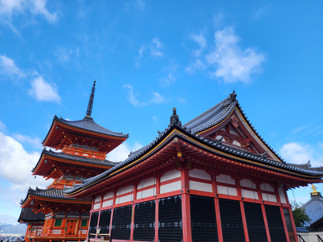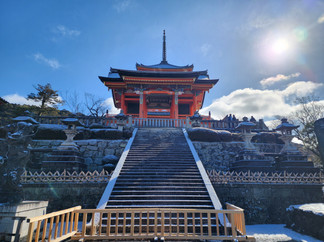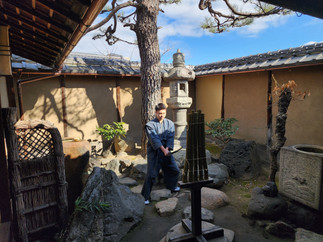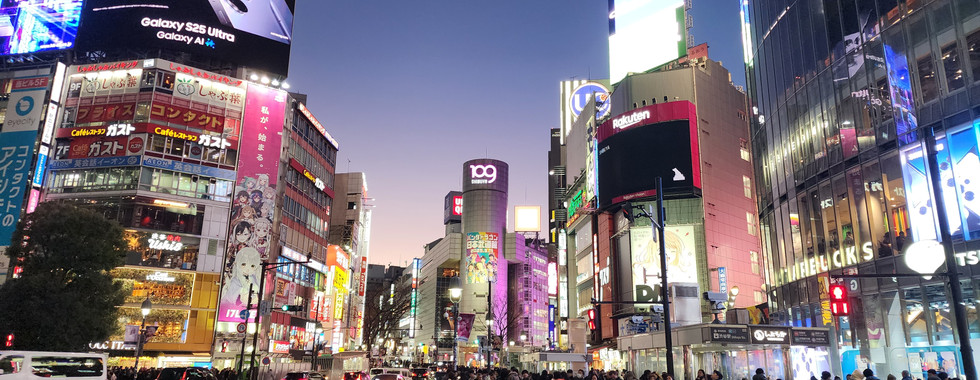Japan Travel Blog: Exploring Kyoto & Tokyo
- adriana hamelin
- Feb 24
- 7 min read
Arrival in Japan in February 2025
Our journey to Japan started with a visit to friends in British Columbia, which conveniently helped break up our long flight. We had booked our flights through United Airlines, but our itinerary involved multiple airlines: an Air Canada flight from Vancouver to Seattle, followed by an All Nippon Airways (ANA) flight from Seattle to Haneda, Tokyo. Checking in was a challenge, as we were bounced between airline apps and had to contact customer service to adjust our seats for the 10-hour flight. Additionally, we needed to pre-select a gluten-free and dairy-free meal at least 24 hours before departure.

Our flight from Vancouver was delayed, but we made our Seattle connection just in time—ANA was even waiting for us at the gate. The 10-hour flight went by quickly with plenty of allergen-free meal options, decent entertainment, and surprising amenities like bidets in the lavatories. The legroom was generous compared to flights from Montreal to Italy. To adjust to the time difference, we stayed awake throughout the flight and arrived in Tokyo at 7 PM.

Upon arrival, we filled out two separate forms per person. The immigration process included fingerprint scanning and a photo. Despite space in the airport, the lines were tightly packed. After clearing customs, we opted for a taxi to our hotel to avoid navigating public transport while exhausted. The taxi driver didn't speak English, but showing the address on our phone worked smoothly. The airport itself was modern, bright, clean, and well-signposted in English, making for a stress-free arrival.
One of the first things we learned in Japan was the importance of simple greetings and polite phrases. “Konnichiwa” (こんにちは) is a friendly “Hello” used throughout the day, while “Konbanwa” (こんばんは) is a polite way to say “Good evening.” Saying “Thank you” is an art in itself. Among friends, a casual “Domo” (どうも) is enough, but a more polite way is “Domo arigato gozaimasu” (どうもありがとう ございます), preferably said with a bow. Unlike in English, you can’t just say “Arigato” on its own because it's only part of the full phrase. Bowing is also a form of expressing gratitude and is deeply ingrained in Japanese culture.
Kyoto: The Journey and Arrival

After a good night's sleep and a mixed Japanese-American breakfast, we worked out before heading to Kyoto via the Shinkansen. While we could have taken public transport to the station, we chose a taxi for efficiency. At Shinagawa Station, we went directly to the counter for assistance rather than using the electronic machines (first time is a bit confusing). Coincidentally, heavy snow caused significant train delays. We purchased non-reserved tickets and followed signs to the platform, encountering a chaotic scene with trains running over an hour late. Blue lines on the floor helped organize boarding, and we managed to get seats on a train.
Even at reduced speeds due to the snow (200km/h instead of close to 300 km/h), the bullet train experience was comfortable, with ample legroom, overhead space for our backpacks, and coat hooks. We caught a glimpse of Fuji mountain, and I even snapped some pictures from the window between cars.
Important tip: always keep your train ticket, as you’ll need it to exit.
Exploring Kyoto
Kiyomizu-dera Temple
Our first stop was Kiyomizu-dera, a UNESCO World Heritage Site founded in 778 AD. The temple has been rebuilt multiple times due to fires. The entrance fee was 500 yen, and inside, we experienced the Tainai Meguri, a pitch-black underground chamber symbolizing rebirth. Following the ritual—placing our left hand on the railing, keeping backpacks in front while praying, and behind us while descending—we reached a rotating stone, making a wish before exiting.
Exploring the surrounding area, we encountered another small temple (100 yen entrance) and the Road of the Ancient Poets, a pleasant walk through a cedar-scented bamboo grove.
Yasaka Pagoda & Gion District
We exited towards Hōkan-ji Temple (Yasaka Pagoda), a five-story, 46-meter-tall landmark built in 589 and rebuilt in 1440. The surrounding street was lined with kimono rental shops and restaurants. We tried a lemon-pickled cucumber on a stick, enjoying it in-store since eating while walking is discouraged. Kyoto has very few public trash cans, so proper disposal is essential.
Further exploration led us to Yasaka Koshindo, a vibrant temple known for its colorful kukurizaru talismans, representing self-control. The area was rich in history, filled with shrines and temples at every turn. We then headed to Hanamikoji Street, Gion’s most famous street, with traditional wooden architecture and signs prohibiting photography in private areas due to past tourist disruptions. A local advised us that geishas often appear in the evening, making a nighttime visit a must for the future.
Nishiki Market
A visit to Kyoto wouldn’t be complete without exploring Nishiki Market, known as "Kyoto’s Kitchen." This narrow, five-block-long shopping street is lined with stalls offering fresh seafood, pickled vegetables, matcha sweets, and traditional Japanese snacks. We admired the colorful displays of Kyoto’s culinary heritage. The market is lively and can get crowded.
OMI Beef & Kyoto's Pure Water

You have to try OMI Beef, which is in the same category as Kobe beef. It’s so good, it melts in your mouth. We were lucky to find a restaurant, literally 2 minutes from the hotel—Shalom. Supper was delicious. The owners were very nice, and we got to have conversations with them. We learned that the water in Kyoto is pure, coming from the lake, which makes veggies and fruits tastier. That same water also makes OMI beef exceptional. In the future, we’d love to return to Shalom and try aged OMI beef.
Samurai Experience
One of the most unique experiences in Kyoto was stepping into the world of the samurai.
Iaido is an ancient martial art practiced by samurai using Japanese swords. One of the most thrilling activities we did was cutting through tatami mats, which simulate the density of a human shoulder. Our samurai sensei demonstrated cutting through five tatami rolls in one strike, mimicking a cut from shoulder to hip. It’s not just about force—it’s about being zen, striking at the right angle, and moving the sword with precision.
Dressing as a samurai, learning the history, practicing with wooden swords, handling a real katana, and ending with a meditation session made this a perfect experience. If you ever get the chance, do it!
For a moment, we felt transported back in time, imagining what life must have been like for these skilled warriors.
Yasaka Shrine & Ofuro Bath Experience
Our final stop was Yasaka Shrine (Gion Shrine), a significant Shinto site over 1,000 years old. As the temperature dropped, we returned to our hotel for a rejuvenating ofuro bath. Like a Japanese onsen experience, the bath involves thoroughly washing before and after soaking, offering relaxation, detoxification, and stress relief.
Final Thoughts on Kyoto
Two nights in Kyoto went by too quickly. We left with a bit of chagrin, wishing for more time. It would be amazing to return in autumn to see the maple leaves changing color—Kyoto maple leaves are as big as the palm of a hand compared to the Canadian maple leaf, which is as big as a full hand. Visiting in April for the cherry blossoms would also be magical.
For the future:
Rent a kimono for a day (about 3,000 yen)
Visit the Tori gates, even if they might be overrated
Go to Uji for high-quality roasted hojicha tea, which you can smell in the streets
Return to Shalom for more OMI beef
Tokyo: A Glimpse of the Future

The Tokyo Experience
We love Japan. In the chikatetsu (subway), people are on their phones, nobody talks or disturbs. It's wonderful. Everything is clean and organized. If you get the chance to witness rush hour, it’s an amusing spectacle as people push themselves into the trains.
Tokyo Night Lights & Guinness World Record Projection
Tokyo's government building hosts a Guinness World Record-certified architectural projection-mapped display, the largest permanent one in the world. The show lasts 15 minutes every 30 minutes from 6 PM to 9:30 PM. Since it was right next to our hotel, we had the chance to see it twice and realized the projections change each time.
Navigating Tokyo's Culture & Etiquette
It’s impossible to count how many times you will hear “Thank you so much” in Japan. People are incredibly respectful and kind. For North Americans, adjusting to the no-tipping culture takes a bit of time. Instead of saying thank you, a simple bow suffices because customers are considered superior to workers. Still, I couldn’t help but say thank you and bow. The level of service is unmatched and something I wish were more common back home.
Exploring Harajuku & Shibuya
We took the metro to Harajuku, explored its vibrant streets, and walked all the way to the famous Shibuya Scramble crossing. We crossed it three times just to soak in the energy. Seeing it from above wasn’t necessary—we preferred being in the middle of it. Walking around Tokyo is an adventure in itself, and you may stumble upon numerous shrines along the way.

One important cultural note: always stand on the left side when using escalators. Unlike North America, where people instinctively keep to the right, in Japan, everyone lines up on the left.
Farewell to Japan
Leaving Tokyo, we flew to Bangkok from Haneda. A north wind caused a departure lane closure, leading to a slight delay. However, the bright side was the breathtaking view of Mount Fuji from the plane.
Final Thoughts & Future Plans
Japan exceeded our expectations, offering a seamless blend of history, culture, and futuristic innovation. Our short trip only scratched the surface, and while Tokyo was an exciting experience, we’re looking forward to exploring more places like Kyoto in the future. Seven days with jet lag flew by too fast, but one thing is certain—we will be back!































































Comments